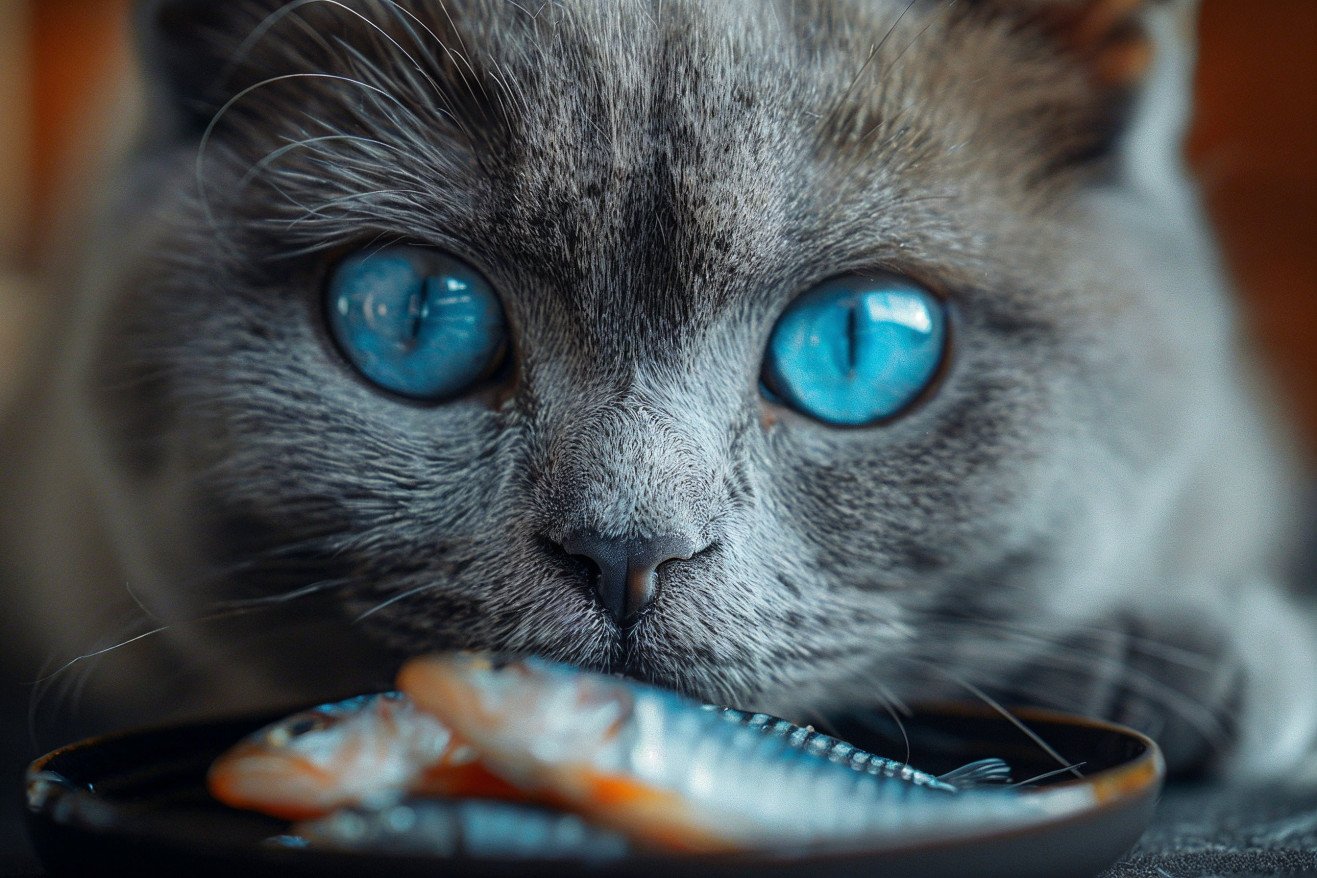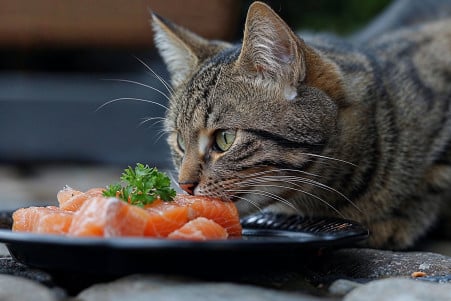Can Cats Eat Sardines? Nutritional Benefits and Feeding Tips
21 February 2024 • Updated 20 February 2024

Sardines may be delicious, but can you share them with your cat? Yes, cats can eat sardines as an occasional treat, and they can be a good source of protein and healthy fats.
However, it’s important to choose sardines packed in water instead of oil, and to limit how often you give them to your cat to once a week to avoid mercury poisoning. Over time, too many sardines can lead to weight gain and nutritional imbalances.
In this deep dive into the nutritional science of cat diets, we’ll explore a wide range of veterinary and nutritional studies. Through this exploration, we can learn about the unique nutritional requirements of cats and how sardines can fit into their diet.
We’ll look at the benefits and drawbacks of how often and how sardines are fed to cats, their impact on feline health, and other, safer sources of protein. This investigation will give you the information you need to decide whether or not to feed your cat sardines.
Can cats eat sardines?
Sardines and the Nutritional Value for Cats
Sardines are full of important nutrients that can help cats. Sardines are a great source of omega-3 fatty acids, which are important for skin and coat health, reducing inflammation, and supporting kidney and heart health, says Hepper. Sardines are also high in protein, which is important for muscle health and overall health.
That said, not all sardines are created equal when it comes to cat nutrition. Cuteness warns that sardines in oil can cause gastrointestinal upset and lead to weight gain, and canned sardines can be high in salt, which can be dangerous for cats. Instead, it’s best to look for sardines in spring water, which will help avoid added sodium and fats.
Portion size and frequency are also important. Vets recommend that sardines make up no more than 10% of a cat’s diet and that they’re given as a treat no more than two to three times a week to avoid mercury poisoning and nutrient imbalances.
In addition, raw sardines contain thiaminase, an enzyme that breaks down thiamine, a B vitamin that’s essential for cats, making it inactive. However, cooking sardines deactivates thiaminase, making them safe to feed to cats.
In short, while sardines can be a great addition to a cat’s diet, they should be fed in moderation and prepared in a way that makes them safe for cats. This is similar to the way that the larger conversation about the role of different proteins in cat nutrition is shaping up.
Why Do Cats Like Fish?
Cats are obligate carnivores, meaning they need animal-based proteins to survive and thrive. Their ancestors were solitary hunters that ate small animals, and fish like sardines can help round out this protein-heavy diet by providing omega-3 fatty acids and a taste that cats love.
That said, a diet that is too heavy in fish can lead to problems. Fish may not contain all the nutrients cats need, and some fish may contain substances that can be harmful in large amounts. It’s also important to note that feeding cats raw or dehydrated non-sterilized fish comes with its own set of risks, including bacterial contamination and parasites.
Because of this, the American Animal Hospital Association and other experts recommend making sure that any commercial cat food you buy has a statement of nutritional adequacy.
It’s also important to make sure that the diet you feed your cat is balanced and meets the specific nutritional needs of domestic cats.
While fish can be part of a balanced diet, it should not be the only source of nutrition. This is in keeping with the idea of feeding cats in a way that is consistent with their natural diet, and it’s also consistent with the idea that a balanced diet that meets nutritional needs is the best way to ensure cats are healthy and thriving.
Best Practices for Processing and Preserving Sardines for Feline Diets
The way sardines are processed and preserved has a major impact on their nutritional value and safety for cats. More traditional methods like chilling, freezing, and super-chilling, as PMC explains, are used to help maintain the quality of fish. These methods are important for preserving the fish’s high levels of protein, vitamins, and essential polyunsaturated fatty acids, including EPA and DHA, which are essential for a cat’s cardiovascular and neurological health.
In addition to these methods, more advanced non-thermal technologies, including pulsed electric field (PEF) and high-pressure processing (HPP), as mentioned by PubMed, are used to ensure the quality of the fish while still maintaining its nutritional value.
When it comes to choosing sardines for cats, it’s important to look for fish that are preserved in spring water. Opting for sardines that are packed in spring water, as explained in research from ScienceDirect, can help you avoid the extra fats and potential health concerns that come with oil-packed sardines.
If fish are stored for too long or processed improperly, it can lead to a loss of the lipid nutritional quality of the fish, which is essential for the health benefits of sardines for cats.
By making sure to follow best practices, including avoiding sardines that have been packed with added salt or preservatives, you can make sure that your cat gets the nutritional benefits without the potential downsides. Being selective about the commercially prepared sardines you choose can help you avoid potential health issues and ensure that your cat’s dietary needs are met.
Managing Mercury Risks in Cat Food
Mercury is a heavy metal that builds up in fish and can be toxic to cats when consumed in high amounts. The Merck Veterinary Manual explains that predatory fish that are higher up the food chain are more likely to have higher mercury levels due to biomagnification.
Since sardines are smaller fish, they are generally safer for cats to eat because they are less likely to have the higher mercury levels found in larger fish like tuna.
Cats that consume too much mercury can experience mercury poisoning, which can lead to a variety of symptoms including neurological problems like ataxia (loss of coordination), tremors, and changes in behavior. Even lower levels of chronic mercury exposure can lead to serious health problems in cats, which underscores the importance of feeding them fish in moderation and making sure that the fish you feed them is lower in mercury.
Cat owners can reduce the risk of mercury exposure in their cats by making sure that the fish they feed them is lower in mercury, like sardines, and feeding it to them in moderation.
Catster explains that by rotating the protein sources in a cat’s diet and avoiding fish that are higher in mercury, you can significantly lower the risk.
It’s also important to make sure that you watch your cat for any signs of mercury poisoning, especially when you first start feeding them fish. By being aware and informed, cat owners can make sure that they can feed their cats fish, including sardines, without putting their health at risk.
Other Protein Options for Cats
While sardines have their own unique benefits, it’s important to make sure your cat is getting a variety of protein sources in their diet. Feline Wellness recommends other proteins like pheasant, duck, and rabbit, which can offer a nice break from fish. These proteins are often from grass-fed and free-range animals, which can ensure that they are of the highest quality and safe for your cat.
FutureBridge notes that plant-based, insect-based, and cell-based proteins are all on the rise in the pet food industry. For example, Purina’s Beyond line of pet food includes insect proteins and plant proteins like millet and fava beans. In addition, companies like Because Animals are working on cell-based meats to create new and sustainable protein options.
Cats have specific nutritional needs, and while they are obligate carnivores, a study in PMC shows that they can digest plant-based proteins. It’s important to take into account your cat’s individual health, likes, dislikes, and any allergies when choosing proteins.
When you’re introducing new proteins, make sure to do it slowly, starting with a small amount and watching your cat’s reaction to make sure they don’t have any digestive issues. By making sure you’re offering a variety of proteins, you can make sure your cat’s diet is as well-rounded as possible and help contribute to their overall health.
Final Thoughts on Cats and Sardines
This article has covered a lot of ground when it comes to feeding your cat sardines. In general, sardines can be a healthy addition to your cat’s diet as long as they are fed in moderation. They can provide your cat with protein and omega-3 fatty acids that can help support their overall health.
However, it’s important to make sure that the sardines you’re feeding your cat are packed in water with no added salt and are cooked to avoid the potential dangers of raw fish.
This article has also emphasized the importance of understanding a cat’s natural diet as obligate carnivores and how sardines can fit into that diet. While sardines are a low-mercury fish, they should still be fed in small amounts to avoid mercury poisoning.
In summary, it’s important to talk to your vet before adding any new food to your cat’s diet, including sardines, to make sure that it’s appropriate for your cat’s specific dietary needs. Your vet can offer personalized recommendations that take into account your cat’s nutritional needs, lifestyle, and health status.
Feeding your cat a variety of protein sources, not just fish, will help ensure that your cat’s diet is well-rounded and meets all of their nutritional needs. By doing this, you can ensure that you’re not just feeding your cat a meal, but you’re also providing them with the foundation for a long, healthy life.


